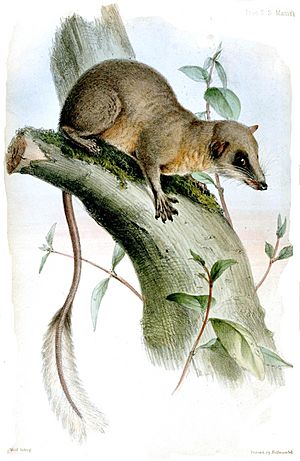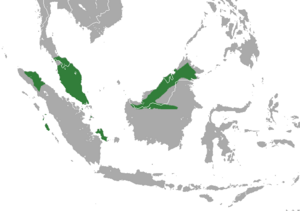Pen-tailed treeshrew facts for kids
Quick facts for kids Pen-tailed treeshrew |
|
|---|---|
 |
|
| Illustration in 1848 species description | |
| Conservation status | |
| Scientific classification | |
| Genus: |
Ptilocercus
|
| Species: |
lowii
|
 |
|
| Pen-tailed treeshrew range | |
The pen-tailed treeshrew (Ptilocercus lowii) is a small mammal that looks a bit like a squirrel. It belongs to a group of animals called treeshrews. This special animal lives in parts of southern Thailand, the Malay Peninsula, Borneo, and some Indonesian islands.
It is the only living species in its group, called Ptilocercus. All other treeshrew species are part of a different family. This makes the pen-tailed treeshrew quite unique!
Contents
Where Pen-tailed Treeshrews Live
Home Sweet Home: Forests and Islands
The pen-tailed treeshrew can be found in a wide area. Its home stretches from southern Thailand and the Malay Peninsula. It also lives on islands like northern Sumatra, Siberut, Bangka Island, and northwestern Borneo.
Preferred Habitat: Dense Forests
These treeshrews love to live in primary forests. These are old, untouched forests. They prefer places where the plants on the ground are very thick and dense. You can find them living up to about 1,200 m (3,900 ft) (about 4,000 feet) high in the mountains.
Amazing Pen-tailed Treeshrew Behavior
A Unique Diet: Special Palm Nectar
Scientists have studied pen-tailed treeshrews in Malaysia. They found that these animals spend many hours at night drinking a special kind of nectar. This nectar comes from the bertam palm tree. What's interesting is that this nectar is naturally fermented.
Handling Fermented Nectar
The bertam palm nectar has one of the highest concentrations of fermented plant sap found in nature. Even though the treeshrews drink a lot of it, they don't seem to get dizzy or show any signs of being affected. They can drink amounts that would be like a human having many glasses of a strong drink!
Scientists think their bodies might process this special nectar in a different way than humans do. This ability to handle large amounts of fermented sap might be something they developed over a very long time. It helps them use this unique food source.
Pen-tailed Treeshrew Family Tree
How Treeshrews Are Classified
The pen-tailed treeshrew belongs to a family called Ptilocercidae. This family is part of a larger group known as Scandentia. Scientists look at many things, like how their bodies are built and their DNA, to classify animals.
Ancient Relatives
These studies show that the Ptilocercidae family is very different from other treeshrews. They separated from other treeshrews about 60 million years ago! Treeshrews are also considered close relatives of primates, which include monkeys and humans. Another animal called the colugo is even closer to primates.


